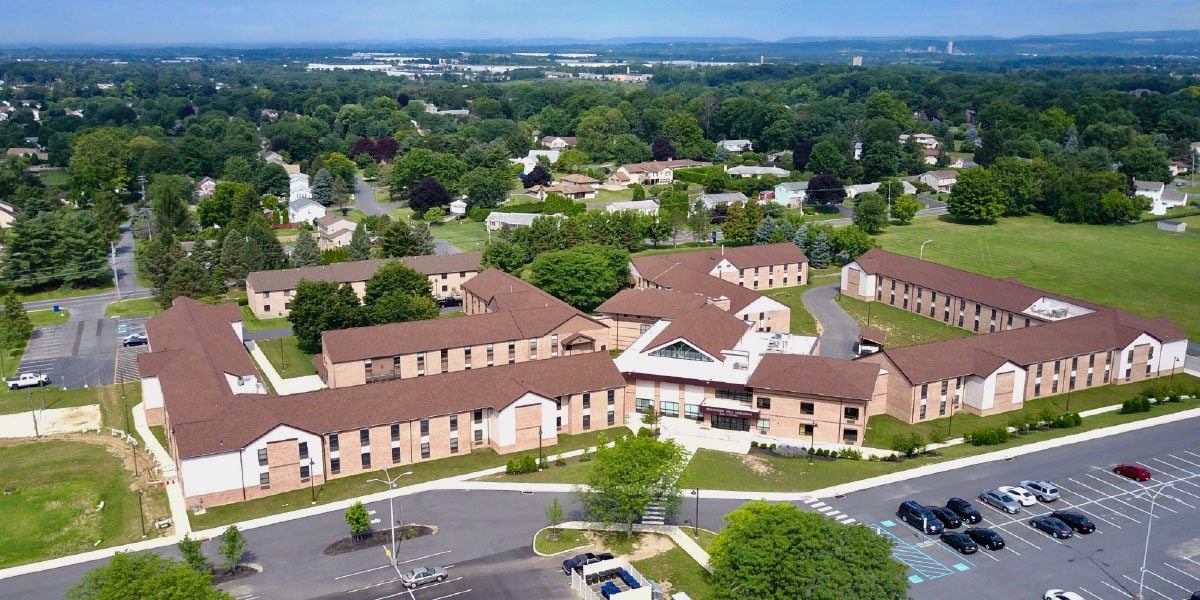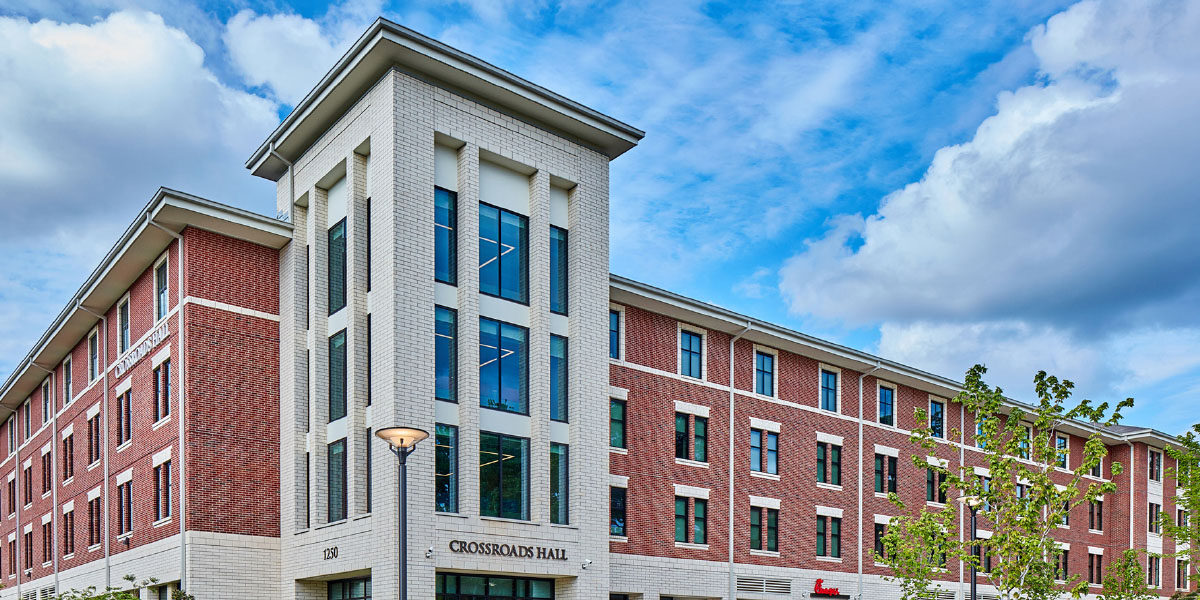Dorm life has long been acknowledged as one of the more memorable aspects of the college experience. College residence halls have been recognized as centers of creativity and engagement, and ultimately, drivers of student success. Musical careers have been launched there (Mike Posner, singer/songwriter); million-dollar screenplays have been written (Evan Daugherty, screenwriter, Snow White and the Huntsman); and successful companies have been started (Sam Yagan, founder, SparkNotes).
Until fairly recently, these kinds of memorable experiences were reserved for students attending four-year colleges and universities. Now, community colleges are also offering on-campus housing. Based on the American Association of Community Colleges’ analysis of the Integrated Postsecondary Education Data System (IPEDS) 2015 institutional characteristics data file, about 28 percent of community colleges provided on-campus housing in 2015. Further, according to a 2010 survey from AACC, 43 community colleges added dorms between 2000 and 2010.
Kent A. Phillippe, AACC’s associate vice president, research and student success, attributes the growth in the number of community colleges offering on-campus housing to their desire to attract specific populations of students. “Some of them are trying to attract a more traditional student population,” he says. “Others want to attract athletes or international students to their campuses. For the more rural institutions, it’s about making housing available to ‘local’ students, who still travel a distance to reach their campuses.”

Building Beginnings
Appealing to international students played a part in the decision to expand on-campus housing at Northampton Community College (NCC), Bethlehem, Pa. “International enrollment is an important market for us,” says James F. Dunleavy, vice president of finance and operations. “We wanted to continue to offer those students competitive learning and housing options.”
In fact, the first on-campus housing offered in 1986, which consisted of 48 apartment units, was built to house out-of-area, out-of-state, and international students. During the 1990s, two more dorms were built, which took the college’s housing capacity to 268 beds. Additional dorms opened in 2015, bringing NCC’s capacity to house students on campus to 600.
At Tyler Junior College (TJC), Tyler, Texas, on-campus housing was first offered in the late 1950s to house athletes. “We have the full gamut of athletics here, including a 200-member band and the award-winning Apache Belles dance lines of 60–80 members,” says Sarah E. Van Cleef, vice president for financial and administrative affairs, and chief financial officer. “However, as our campus has grown, so has the demand for housing. We’ve more than doubled the bed capacity during my tenure.”
In 2007, TJC built its largest dorm with the capacity to house 462 students. Construction of its newest dorm was completed in 2015. In total, the college has 1,200 beds available on campus, which aren’t nearly enough to accommodate its 11,500 students. And with a 300-person waiting list for fall, the demand for housing is evident. However, Van Cleef emphasizes, “As a community college, we are fortunate to be able to offer dorms on campus. While it would be nice to have capacity to always meet demand, this is simply not a realistic business model for TJC.”
Similarly, while Yavapai College in Prescott, Ariz., has offered residential housing for close to 50 years, it’s not likely that all of its almost 3,500 students will ever live on campus. “Our two residence halls were built on the main campus a few years after the formation of the college and were intended to give local students a chance to move out of the house and live independently, but in a supervised environment,” says Clint Ewell, vice president of finance and administrative services.
The college has 220 beds total for students who want to live on campus. “When I got here in 2010, the residence halls were on their last legs,” Ewell says. “We worked with a consultant to determine whether our best option was to exit, rebuild, or renovate, and we decided to renovate, beginning that process in 2012.”
Although the on-campus housing capacity of these institutions varies widely, all three remain committed to making this option available to their students. As such, these community colleges have carefully considered how their investment in housing facilities will impact their brand, finances, and culture.

Making Their Mark
Offering on-campus housing is a significant way for community colleges to distinguish themselves in the marketplace. “We wanted to continue to differentiate ourselves,” Dunleavy says of the decision to build NCC’s housing program to its current capacity. “On-campus housing is unique in the world of community colleges.”
It has also helped to increase interest in some of the specialized programs that NCC offers. “It has allowed us to grow some targeted programs, such as funeral services, nursing, hospitality, and culinary services,” Dunleavy notes. “Students are able to come here and enroll in niche programs that are not available to them closer to home.”
In general, he sees NCC’s residential housing program as a competitive advantage that has “strengthened and broadened campus culture significantly and made for a richer experience for everyone, while enhancing our brand and allowing us to become more competitive internationally.”
Whether internationally or locally, on-campus housing is a draw. “We have six different locations, but we only have residence halls on the original campus,” says Yavapai College’s Clint Ewell. “For those students who want to be on the main campus and have a more traditional college experience, they can stay in the residence halls.”
He also notes that in the state of Arizona, counties tend be larger in size, which makes the community college’s on-campus housing “an asset for local students for whom it’s not practical to leave town but want to live on campus.”
According to Ewell, “There are a lot of people living in outlying communities who now have the opportunity to live on campus, rather than taking courses online or having [up to] a two-hour commute to campus, so more of them can get started on their academic careers.”
Van Cleef describes TJC’s on-campus housing as “a huge recruitment tool.” For instance, in the residence halls, some of the floors are organized by students’ affiliations, which she says helps with recruitment. “Offering on-campus housing grows affinity groups on campus, which enhance engagement. This makes for a more fulfilling experience for students,” Van Cleef says.
“In terms of demand, we could support another residence hall,” she continues. “We’ve even acquired some land in the area, but we’re not slating it for housing. We could never build enough housing for all our students.”

Balancing the Budget
Even with all the benefits they bring in terms of marketing and recruitment, all three CBOs emphasize that the housing initiatives on their campuses first had to meet specific fiscal criteria to move forward.
“We worked on feasibility studies and ran a lot of what-if scenarios and models,” Dunleavy explains. “Conducting feasibility studies to identify the demand for housing and the future pipeline of students is critical. Once you solidify enrollment potential, you can run the financials.
“We ended up positioning the ownership of the residence halls within our foundation, which is part of the endowment,” he continues. “We keep the financial operations of the housing at arm’s length from the college.”
NCC has taken a three-phased approach to providing on-campus housing. The first two phases focused on the construction of new dorms primarily for housing out-of-county and international students. The third phase makes on-campus housing available to in-county students for the first time.
“One of the driving forces behind the third phase was that we kept having a waiting list, but we didn’t have the capacity to house any more students,” Dunleavy says. “Once we saw there was still demand for on-campus housing, we did additional feasibility studies to determine the source of the demand. We were meeting our occupancy rates and still hadn’t offered housing to any in-county students, which was our safety net if demand from students outside the country went down.”
All three phases of NCC’s housing initiative were funded through 20-year bond financing. “We paid debt service with revenue from the residence halls,” Dunleavy notes. “By the time we got to phase three, we had basically paid off the debt service on the first two phases, and we had a pretty well-established revenue source. Doing this in phases helped us significantly.
“In general, we were not looking at housing as a profit-making center,” he continues. “The goal was to break even and cover debt service and incremental costs such as maintenance and utilities. When you package the costs of our room and board, tuition, and fees, you get the four-year feel for less money.”
Renovation Rewards
Similar fiscal goals informed Yavapai College’s renovation of its residence halls. “We had been offering on-campus housing at a deeply discounted rate based on the poor physical condition of the dorms,” Ewell explains. “With the renovation, we brought rates closer to market value. It’s still a great deal, but rates are closer to what you might find for housing in the general community.”
The college issued a revenue bond to fund the renovation, and according to Ewell, today the halls are self-supporting. “Renovation was a more cost-effective option. Still, 2012 was not the best time to begin the project, and we had to be cost conscious. It was a huge factor for us that the project be able to pay for itself.”
As a member of the president’s leadership team (comprising the top 18 administrators at the college) that made the decision to move forward with the renovation, Ewell says, “I was one voice at the table. My perspective was bringing forward the financial implications while focusing on what kind of campus culture we wanted to have moving forward.”
At Tyler Junior College, no state funds were used to build the residence halls, which Van Cleef describes as “self-sufficient, separate auxiliaries.” Instead, revenue bonds were issued to cover the cost of their construction. With TJC’s AA+ rating from Standard & Poor’s, there was no need to pursue a public-private partnership. “We wanted to manage the housing ourselves and have it as an asset,” she explains. “Usually we can obtain debt more competitively on our own than going through a lender.”
Van Cleef’s role in managing the housing function is ongoing. “Managing residential life as well as the other departments that support housing, operationally, allows necessary collaboration” she explains. “The financial aid department also reports to me,” Van Cleef continues, “and that’s been a good partnership with the residence life department. All the departments that support housing on your campus have to work together.”
Stepping Up Support Services
“It keeps it interesting,” says Van Cleef of the decision to offer on-campus housing. “It’s not something that all community colleges have, and you need to offer a lot of the other relative services to support housing that commuter schools traditionally don’t offer.”
Dunleavy concurs: “At 600 beds, we’re a full-service housing operation, so we had to ramp up our student life programs. Within our student life area, we expanded our counseling and advising services, and with approximately 400 of the 600 students now staying on campus on weekends, you’ve got to be able to keep them occupied by expanding fitness center hours, for example, and offering more social activities such as dances and student life club activities.”
At Yavapai College, campus leaders gave careful consideration to the features that would appeal to students in terms of the design of its renovated dorms. “Having a consultant on board helped us determine what amenities we would incorporate into the existing structures,” Ewell says. “We added study spaces and outdoor spaces for students to gather or play sports.”
The college also upgraded its dining facilities and repurposed an enlarged classroom to create a student activity lounge. “It’s a place for all students—not just resident students—to gather and socialize outside of class,” Ewell notes. “A big driver of retention is getting students to build relationships both in and out of class, so that they feel a part of the community.”
Maintaining the safety of that community is also paramount. TJC, for example, has implemented additional security measures. “We’re open enrollment and open access,” Van Cleef says. “Now with 1,100-plus students living on campus, everyone wears lanyards to identify themselves, and we also do background checks on students who apply for on-campus housing.”
She adds, “Once you offer housing on your campus, you have to support a robust student life program and keep the campus community active and safe.”
APRYL MOTLEY, Columbia, Md., covers higher education business issues for Business Officer.



